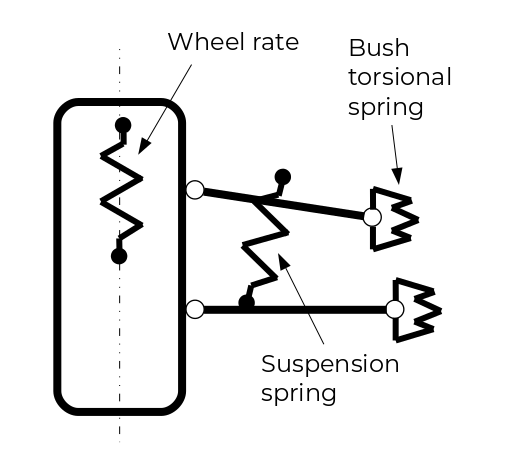Wheel Rate – Suspension KPI
Wheel rate is a measure of the effective stiffness of the suspension system measured at the wheel centre. The wheel rate is the slope of a graph plotting wheel force vs wheel travel. It is expressed in Newtons per metre or N/m.
The primary contributor to the wheel rate is the suspension spring. If the suspension system has rubber bushes at the joints, the torsional stiffness of the bushes also contributes to the wheel rate of the suspension. Wheel rate in roll also includes the contribution of the anti-roll bar.

The wheel rate of a suspension system can be used to calculate the ride frequency of a vehicle if the sprung mass is known. Ride frequency in hertz is given by:
Ride Frequency = 0.1592 * sqrt(wheel_rate/sprung_mass)
Typically passenger cars with a ride frequency below 1 Hz are considered softly sprung and are orientated towards comfort. Rolls Royce cars for example are less than 0.8 Hz. Most passenger cars have ride frequencies between 1.2 and 1.6 Hz with sportier cars around 1.8 – 2 Hz. F1 cars are > 3 Hz, but this would not be recommended for any car that drives on anything other than smooth race tracks.
In general rear ride frequencies on most cars are ~10-20% higher on the rear axle compared to the front. The reason for this is due to the time delay between the front axle hitting an obstacle and the rear axle hitting the same obstacle. A higher ride frequency on the rear helps the rear axle to ‘catch up’ with the front axle as the suspension oscillates after the impact.
A good rule of thumb for suspension design is to use the softest wheel rate you can deliver the body control you require. Stiffer is not always better. As an example, consider the Lotus Elise. It is relatively softly sprung for a sports car at ~1.4 Hz. I suspect this is due to its low weight coupled with a low centre of gravity reducing the need for the springs to control body roll during cornering.
—
ENHANCE YOUR CHASSIS AND SUSPENSION SYSTEMS EXPERTISE WITH CUTTING-EDGE SOFTWARE SOLUTIONS AND SUSPENSION COURSES
AUTOMOTIVE/MOTORSPORT SUSPENSION AND CHASSIS SYSTEMS – DESIGN AND ENGINEERING FUNDAMENTALS COURSE
SUSPENSION PERFORMANCE TUNING USING MULTIBODY SIMULATION SOFTWARE COURSE
START USING RACE SOFTWARE TODAY WITH A FREE TRIAL ON ALL PLANS
